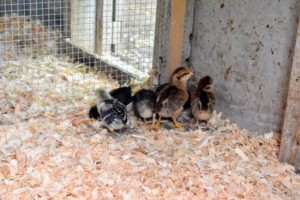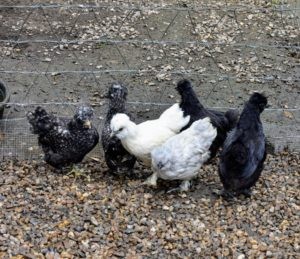Pet Chickens are becoming increasingly popular, and at PETS.EDU.VN, we’re here to guide you through everything you need to know about these feathered friends. From providing fresh eggs to offering companionship, keeping chickens as pets can be a rewarding experience. If you’re considering raising fowl, want to learn about breeds, or need advice on chicken care, this comprehensive guide offers valuable insights to help you succeed.
1. Why Choose Pet Chickens?
Keeping pet chickens has numerous advantages. They are a great source of fresh eggs, can help control garden pests, and offer a unique form of companionship. But before you get started, it’s essential to understand their needs and how to properly care for them. Let’s explore the world of pet chickens and discover why they make fantastic additions to many households.
1.1. Benefits of Raising Pet Chickens
Raising pet chickens offers several benefits, making them a worthwhile addition to your backyard. Here are some key advantages:
- Fresh Eggs: One of the most significant benefits of keeping chickens is the constant supply of fresh eggs. According to the USDA, eggs from backyard chickens can be more nutritious due to the chickens’ varied diet and access to sunlight.
- Pest Control: Chickens love to forage for insects and larvae, helping to keep your garden free of pests. A study by the University of California found that chickens are effective at reducing populations of garden pests like snails, slugs, and certain insects.
- Natural Fertilizer: Chicken manure is a rich source of nitrogen, phosphorus, and potassium, making it an excellent natural fertilizer for your garden. Properly composted chicken manure can enhance soil fertility and plant growth, as noted by the Rodale Institute.
- Companionship: Chickens can be surprisingly social animals. Many owners find enjoyment in watching their chickens, interacting with them, and even training them. Their unique personalities can provide entertainment and companionship.
- Educational Value: Raising chickens can be a great educational experience, especially for children. It teaches responsibility, animal care, and the importance of sustainable living.
1.2. Understanding Different Chicken Breeds for Pets
Choosing the right chicken breed is crucial for a successful pet chicken experience. Different breeds have different temperaments, egg-laying abilities, and environmental needs. Here are some popular breeds for pets:
| Breed | Temperament | Egg Laying | Climate | Special Features |
|---|---|---|---|---|
| Silkie | Docile, Friendly | Moderate | All Climates | Fluffy feathers, good for children |
| Orpington | Gentle, Calm | Good | All Climates | Broody hens, good egg layers |
| Rhode Island Red | Hardy, Friendly | Excellent | Cold Hardy | Prolific egg layers |
| Plymouth Rock | Docile, Dual-Purpose | Good | Cold Hardy | Good for both meat and eggs |
| Easter Egger | Friendly, Curious | Moderate to Good | All Climates | Lays colorful eggs (blue, green, pink) |
| Cochin | Gentle, Calm | Moderate | All Climates | Fluffy feathers, docile and friendly |
| Wyandotte | Hardy, Dual-Purpose | Good | Cold Hardy | Beautiful plumage, good for both meat and eggs |
| Sussex | Curious, Friendly | Excellent | All Climates | Good layers of brown eggs, adaptable |
| Australorp | Docile, Calm | Excellent | All Climates | Holds the record for most eggs laid in a year |
| Leghorn | Active, Alert | Excellent | Warmer Climates | Prolific layers of white eggs, may not be as friendly |







Consider your climate, space availability, and desired egg production when choosing a breed. According to the Livestock Conservancy, selecting heritage breeds can also help preserve genetic diversity and support sustainable farming practices.
1.3. Legal Considerations Before Getting Pet Chickens
Before bringing chickens home, it’s crucial to check local regulations. Many municipalities have specific rules about keeping poultry.
- Zoning Laws: Many cities have zoning laws that dictate whether you can keep chickens. Some areas only allow chickens on larger properties or in agricultural zones. Check with your local zoning department to understand the regulations.
- Number of Chickens: Some ordinances limit the number of chickens you can keep based on your property size. This is to prevent overcrowding and maintain sanitary conditions.
- Rooster Restrictions: Roosters are often banned in urban areas due to their loud crowing. If you live in a residential neighborhood, you might only be allowed to keep hens.
- Coop Requirements: Local laws may specify the size, location, and construction standards for chicken coops. Ensure your coop meets these requirements to avoid violations.
- Health and Safety: Some municipalities have regulations regarding waste disposal, pest control, and disease prevention to protect public health.
Failing to comply with local regulations can result in fines or being forced to remove your chickens. Always research and adhere to local laws to ensure a smooth and legal chicken-keeping experience. Contact your local government or homeowner’s association for detailed information on regulations in your area.
2. Setting Up Your Chicken Coop
Creating the right environment for your pet chickens is essential for their health and well-being. A well-designed coop provides safety, comfort, and space for your chickens to thrive.
2.1. Essential Components of a Chicken Coop
A proper chicken coop should include several essential components:
- Space: Chickens need adequate space to move around. A general rule is at least 4 square feet per chicken inside the coop and 8-10 square feet per chicken in the outdoor run. Overcrowding can lead to stress and disease.
- Protection from Predators: The coop must be secure enough to protect chickens from predators like foxes, raccoons, and hawks. Use sturdy wire mesh and ensure all openings are properly sealed.
- Ventilation: Proper ventilation is crucial to prevent moisture buildup and ammonia fumes. Ensure the coop has vents near the roof to allow air circulation without creating drafts.
- Nesting Boxes: Provide one nesting box for every 3-4 hens. Nesting boxes should be dark, quiet, and lined with soft bedding like straw or wood shavings to encourage egg-laying.
- Roosts: Chickens prefer to roost off the ground. Provide roosting bars at least 2-3 feet off the ground and ensure they are smooth and easy to grip.
- Easy Cleaning: Design the coop for easy cleaning to maintain hygiene and prevent disease. Removable trays or floors can simplify the cleaning process.
2.2. Building vs. Buying a Chicken Coop
You have two main options for acquiring a chicken coop: building one yourself or buying a pre-made coop.
- Building a Coop:
- Pros:
- Customization: You can design the coop to fit your specific needs and space.
- Cost-Effective: Building can be cheaper if you have the necessary skills and materials.
- Satisfaction: Building your own coop can be a rewarding experience.
- Cons:
- Time-Consuming: Building a coop takes time and effort.
- Skill Required: Requires carpentry and construction skills.
- Potential Errors: Mistakes can be costly and time-consuming to fix.
- Pros:
- Buying a Coop:
- Pros:
- Convenience: Pre-made coops are easy to set up.
- Quality: Reputable manufacturers ensure quality and durability.
- Design: Available in various designs to suit different needs.
- Cons:
- Cost: Can be more expensive than building.
- Limited Customization: May not perfectly fit your specific requirements.
- Assembly Required: Some assembly may be necessary.
- Pros:
Consider your budget, skills, and time availability when deciding whether to build or buy a chicken coop.
2.3. Placement and Environmental Considerations for Chicken Coops
The location of your chicken coop can significantly impact your chickens’ health and happiness.
- Sunlight: Place the coop in an area that receives partial sunlight. Sunlight helps keep the coop dry and warm, especially during colder months.
- Drainage: Ensure the area has good drainage to prevent water from accumulating around the coop, which can lead to muddy conditions and disease.
- Protection from Wind: Position the coop to protect it from strong winds, which can make chickens uncomfortable and increase the risk of illness.
- Proximity to House: Locate the coop close enough to your house for easy access but far enough to minimize noise and odor.
- Accessibility: Ensure the coop is easily accessible for cleaning, feeding, and collecting eggs.
- Predator Protection: Consider the surrounding environment and take measures to protect against predators. This might include fencing, motion-activated lights, or guard animals.
Proper placement and environmental considerations can create a safe and comfortable environment for your pet chickens.
3. Chicken Nutrition and Feeding
Proper nutrition is vital for the health, egg production, and overall well-being of your pet chickens. A balanced diet ensures they receive the necessary nutrients to thrive.
3.1. What Do Pet Chickens Eat?
Chickens are omnivores and require a varied diet that includes protein, carbohydrates, vitamins, and minerals. The ideal diet depends on their age and purpose (e.g., laying hens vs. meat birds).
- Chick Starter Feed: From hatch to 6-8 weeks, chicks need a starter feed with high protein content (around 20%) to support rapid growth.
- Grower Feed: From 8 weeks to laying age (around 18-20 weeks), switch to a grower feed with a slightly lower protein content (around 16%).
- Layer Feed: Once hens start laying eggs, provide a layer feed with around 16% protein and added calcium for strong eggshells.
- Scratch Grains: Scratch grains like cracked corn and wheat can be offered as a treat, but should not make up the bulk of their diet.
- Vegetables and Fruits: Supplement their diet with fresh vegetables and fruits like leafy greens, berries, and melons.
- Grit: Provide grit (small stones or sand) to help chickens digest their food properly.
- Water: Ensure chickens have access to fresh, clean water at all times.
According to the American Veterinary Medical Association, a balanced diet is crucial to prevent nutritional deficiencies and health problems in chickens.
3.2. Creating a Balanced Diet for Chickens
Creating a balanced diet for your chickens involves providing a variety of foods that meet their nutritional needs. Here’s how to ensure your chickens get the right nutrients:
- Commercial Feed: Choose high-quality commercial feed that is formulated for the specific age and purpose of your chickens.
- Supplements: Supplement their diet with fresh vegetables, fruits, and herbs to provide additional vitamins and minerals.
- Treats in Moderation: Offer treats like scratch grains, mealworms, or sunflower seeds in moderation to avoid obesity and nutritional imbalances.
- Calcium: Ensure laying hens have access to a calcium supplement like oyster shells to support strong eggshells.
- Probiotics: Consider adding probiotics to their diet to promote gut health and boost their immune system.
- Avoid Toxic Foods: Avoid feeding chickens foods that are toxic to them, such as chocolate, avocado pits, and raw beans.
A well-balanced diet is essential for maintaining your chickens’ health and productivity.
3.3. Feeding Schedules and Tips
Establishing a feeding schedule and following some helpful tips can make feeding your chickens easier and more effective.
- Consistency: Feed your chickens at the same time each day to establish a routine.
- Free-Feeding: Provide feed in a feeder that allows chickens to eat freely throughout the day.
- Morning and Evening: Offer fresh vegetables and fruits in the morning and scratch grains in the evening.
- Water Management: Check waterers daily to ensure they are clean and full.
- Seasonal Adjustments: Adjust their diet based on the season. During colder months, they may need more energy-rich foods to stay warm.
- Monitor Body Condition: Regularly check your chickens’ body condition to ensure they are not underweight or overweight.
Following these feeding schedules and tips can help you keep your chickens healthy and productive.
4. Chicken Health and Wellness
Maintaining the health and wellness of your pet chickens involves regular monitoring, preventive care, and prompt treatment of any health issues.
4.1. Common Chicken Diseases and Prevention
Chickens are susceptible to various diseases, but many can be prevented with proper care and management. Here are some common chicken diseases and how to prevent them:
| Disease | Symptoms | Prevention |
|---|---|---|
| Coccidiosis | Bloody diarrhea, lethargy, weight loss | Keep coop clean and dry, use coccidiostat in chick starter feed, provide probiotics. |
| Avian Influenza | Respiratory distress, decreased egg production, sudden death | Practice biosecurity measures, isolate new birds, vaccinate (if available). |
| Newcastle Disease | Respiratory distress, neurological signs, decreased egg production | Vaccinate, practice biosecurity measures, control wild bird contact. |
| Fowl Pox | Wart-like lesions on skin and comb | Vaccinate, control mosquito populations. |
| Marek’s Disease | Paralysis, tumors | Vaccinate chicks at hatch, maintain a clean environment. |
| Infectious Bronchitis | Respiratory distress, decreased egg production, misshapen eggs | Vaccinate, maintain good ventilation in the coop. |
| Mycoplasmosis | Respiratory distress, swollen joints | Purchase birds from reputable sources, maintain good ventilation. |
| Bumblefoot | Swelling and lameness in foot | Provide soft bedding, ensure roosts are not too high, keep coop clean and dry. |
| Scaly Leg Mites | Scaly, crusty legs | Treat with appropriate miticide, maintain a clean environment. |
According to the Centers for Disease Control and Prevention (CDC), maintaining good hygiene and biosecurity practices is crucial to prevent the spread of diseases in chickens.
4.2. Recognizing Signs of Illness in Chickens
Early detection of illness is crucial for effective treatment. Here are some signs of illness to watch for in your chickens:
- Lethargy: Reduced activity level, reluctance to move.
- Loss of Appetite: Decreased food and water consumption.
- Respiratory Distress: Coughing, sneezing, nasal discharge.
- Diarrhea: Loose or watery stools, possibly with blood.
- Decreased Egg Production: Sudden drop in egg laying.
- Abnormal Droppings: Changes in color, consistency, or frequency of droppings.
- Feather Loss: Excessive feather loss or abnormal feather condition.
- Skin Lesions: Sores, bumps, or discoloration on the skin.
- Lameness: Difficulty walking or limping.
- Changes in Behavior: Unusual aggression, isolation, or other behavioral changes.
If you notice any of these signs, consult with a veterinarian experienced in poultry care.
4.3. Basic Chicken First Aid and Care
Having a basic first aid kit and knowing how to provide basic care can help you address minor health issues in your chickens. Here are some essential items for your chicken first aid kit:
- Antiseptic Solution: For cleaning wounds and preventing infection.
- Bandages: For covering and protecting wounds.
- Gauze Pads: For cleaning and dressing wounds.
- Tweezers: For removing splinters or foreign objects.
- Syringe: For administering medications or flushing wounds.
- Electrolyte Solution: For rehydrating sick chickens.
- Wound Care Ointment: For promoting healing and preventing infection.
- Probiotics: For supporting gut health and boosting the immune system.
- Gloves: For protecting yourself from potential infections.
Here are some basic care tips:
- Isolate Sick Chickens: Separate sick chickens from the rest of the flock to prevent the spread of disease.
- Clean Wounds: Clean any wounds with antiseptic solution and apply a bandage if necessary.
- Provide Supportive Care: Ensure sick chickens have access to fresh water, nutritious food, and a comfortable environment.
- Administer Medications: Follow your veterinarian’s instructions for administering any prescribed medications.
- Monitor Progress: Regularly check on sick chickens to monitor their progress and adjust care as needed.
Providing prompt and appropriate care can help your chickens recover quickly from minor illnesses and injuries.
5. Chicken Behavior and Training
Understanding chicken behavior and implementing basic training techniques can enhance your relationship with your feathered friends and make them more manageable.
5.1. Understanding Chicken Social Behavior
Chickens are social animals with complex behaviors. Understanding their social dynamics can help you manage your flock effectively.
- Pecking Order: Chickens establish a social hierarchy known as the pecking order, where some birds are dominant over others. This hierarchy determines access to food, water, and roosting spots.
- Communication: Chickens communicate through a variety of vocalizations, body language, and visual cues. Understanding these signals can help you interpret their needs and behaviors.
- Dust Bathing: Chickens engage in dust bathing to remove parasites and maintain feather health. Provide a dust bath area with dry soil or sand.
- Foraging: Chickens love to forage for food. Provide opportunities for them to scratch and peck in a safe environment.
- Roosting: Chickens prefer to roost off the ground at night. Provide roosting bars or platforms in the coop.
- Nesting: Hens seek out quiet, dark places to lay their eggs. Provide nesting boxes with soft bedding.
According to a study by the University of Bristol, chickens exhibit sophisticated social behaviors and cognitive abilities, including problem-solving and communication skills.
5.2. Basic Training Techniques for Pet Chickens
While chickens may not be as trainable as dogs, you can teach them basic commands and behaviors using positive reinforcement techniques.
- Clicker Training: Use a clicker to mark desired behaviors and reward with treats.
- Target Training: Teach chickens to follow a target stick to guide them to specific locations.
- Recall Training: Train chickens to come when called by using a specific sound or word and rewarding them with treats.
- Roost Training: Encourage chickens to roost in the coop at night by placing them on the roosting bars and rewarding them with treats.
- Handling: Get chickens used to being handled by gently picking them up and holding them for short periods.
Consistency and patience are key to successful chicken training.
5.3. Enriching the Lives of Your Chickens
Providing enrichment activities can enhance the physical and mental well-being of your chickens.
- Dust Bathing Area: Create a dust bathing area with dry soil, sand, or wood ash.
- Foraging Opportunities: Scatter feed in the coop or run to encourage foraging behavior.
- Perches and Swings: Provide perches, swings, or other elevated surfaces for chickens to climb and explore.
- Vegetable Treats: Offer fresh vegetables like lettuce, spinach, or kale as a treat.
- Interactive Toys: Provide interactive toys like treat balls or puzzle feeders to keep chickens entertained.
- Mirrors: Chickens may enjoy looking at their reflection in a mirror.
- Rotation of Environment: Rotate the chickens to new areas to allow them to explore new sights and smells.
Enrichment activities can help prevent boredom and behavioral problems in chickens.
6. Egg Production and Management
Managing egg production is a key aspect of keeping pet chickens. Understanding the factors that influence egg laying and implementing proper management practices can help you maximize egg production.
6.1. Factors Affecting Egg Laying
Several factors can affect egg laying in chickens:
- Breed: Different breeds have different egg-laying capabilities. Some breeds are prolific layers, while others lay fewer eggs.
- Age: Hens typically lay the most eggs during their first two years of life. Egg production declines as they get older.
- Nutrition: A balanced diet with adequate protein, calcium, and vitamins is essential for egg production.
- Light: Chickens need at least 14-16 hours of light per day to lay eggs. Egg production decreases during the winter months when daylight hours are shorter.
- Stress: Stressful conditions such as overcrowding, predator attacks, or sudden changes in environment can reduce egg production.
- Health: Illnesses or parasites can negatively impact egg laying.
- Molting: Hens stop laying eggs during molting, which is the natural process of shedding old feathers and growing new ones.
6.2. Encouraging Egg Production
To encourage egg production, consider the following:
- Provide a Balanced Diet: Feed chickens a high-quality layer feed with adequate protein, calcium, and vitamins.
- Ensure Adequate Light: Provide supplemental lighting during the winter months to maintain 14-16 hours of light per day.
- Reduce Stress: Minimize stress by providing a safe, comfortable environment with adequate space and protection from predators.
- Maintain Good Health: Prevent and treat illnesses and parasites promptly.
- Provide Nesting Boxes: Offer quiet, dark nesting boxes with soft bedding to encourage hens to lay eggs.
- Collect Eggs Regularly: Collect eggs daily to prevent hens from becoming broody and stopping egg production.
6.3. Troubleshooting Common Egg-Laying Problems
Here are some common egg-laying problems and how to troubleshoot them:
- Hens Not Laying:
- Possible Causes: Age, breed, nutrition, light, stress, health, molting.
- Solutions: Provide a balanced diet, ensure adequate light, reduce stress, address health issues, allow hens to molt naturally.
- Soft-Shelled Eggs:
- Possible Causes: Calcium deficiency, stress, disease.
- Solutions: Supplement with calcium (oyster shells), reduce stress, treat any underlying health issues.
- Thin-Shelled Eggs:
- Possible Causes: Calcium deficiency, disease.
- Solutions: Supplement with calcium, treat any underlying health issues.
- Misshapen Eggs:
- Possible Causes: Stress, disease, age.
- Solutions: Reduce stress, treat any underlying health issues, allow hens to age naturally.
- Egg Eating:
- Possible Causes: Calcium deficiency, boredom, overcrowding.
- Solutions: Supplement with calcium, provide enrichment activities, ensure adequate space.
Addressing these common egg-laying problems can help you maintain consistent egg production in your flock.
7. Integrating New Chickens Into Your Flock
Introducing new chickens to an existing flock requires careful management to minimize stress and prevent aggression.
7.1. Quarantine Period
Before introducing new chickens to your flock, it is essential to quarantine them for at least 30 days.
- Purpose: Quarantine allows you to monitor the new chickens for any signs of illness or parasites without exposing your existing flock.
- Setup: Keep the new chickens in a separate coop and run, away from your existing flock.
- Monitoring: Observe the new chickens daily for any signs of illness, such as lethargy, loss of appetite, respiratory distress, or abnormal droppings.
- Biosecurity: Practice strict biosecurity measures, such as wearing separate clothing and washing your hands thoroughly after handling the new chickens.
7.2. Gradual Introduction Techniques
Once the quarantine period is over and the new chickens appear healthy, you can begin the gradual introduction process.
- Visual Contact: Allow the new and existing chickens to see each other through a fence or wire mesh for several days. This allows them to get used to each other’s presence without direct contact.
- Supervised Visits: After a few days of visual contact, allow the chickens to have supervised visits in a neutral area. Monitor their behavior closely and separate them if any aggression occurs.
- Gradual Integration: Gradually increase the amount of time the chickens spend together, while continuing to monitor their behavior.
- Nighttime Integration: Once the chickens seem to be getting along, you can try integrating them into the same coop at night, when they are less active.
7.3. Managing Aggression During Introductions
Aggression is common during introductions, but it can be managed with the following strategies:
- Provide Adequate Space: Ensure the chickens have plenty of space to move around and avoid each other.
- Multiple Feeding and Watering Stations: Provide multiple feeding and watering stations to reduce competition.
- Distraction: Use distractions such as treats or toys to redirect aggressive behavior.
- Intervention: If aggression becomes severe, intervene by separating the aggressive chickens and reintroducing them later.
- Pecking Order: Allow the chickens to establish a new pecking order naturally, as long as the aggression is not causing injury.
With careful management and patience, you can successfully integrate new chickens into your flock and maintain a harmonious environment.
8. Protecting Chickens from Predators
Protecting your pet chickens from predators is crucial for their safety and well-being. Various predators can pose a threat to chickens, so it is important to implement effective protection measures.
8.1. Identifying Potential Predators
Common predators of chickens include:
- Foxes: Foxes are opportunistic hunters that prey on chickens, especially at dawn and dusk.
- Raccoons: Raccoons are nocturnal predators that can open simple latches and climb fences to access chickens.
- Hawks: Hawks are birds of prey that can swoop down and snatch chickens from the ground.
- Owls: Owls are nocturnal hunters that can prey on chickens at night.
- Coyotes: Coyotes are adaptable predators that can pose a threat to chickens in rural areas.
- Snakes: Snakes can prey on chicks and eggs.
- Dogs and Cats: Domestic dogs and cats can also pose a threat to chickens if not properly trained.
8.2. Coop Security Measures
Securing your chicken coop is essential for protecting chickens from predators.
- Sturdy Construction: Build the coop with sturdy materials that predators cannot easily break through.
- Wire Mesh: Use wire mesh with small openings to cover all openings in the coop and run.
- Secure Latches: Use secure latches that predators cannot open.
- Roof: Cover the coop and run with a roof to protect chickens from aerial predators.
- Buried Fencing: Bury wire mesh around the perimeter of the coop and run to prevent predators from digging underneath.
- Hardware Cloth: Reinforce the bottom of the coop and run with hardware cloth to prevent predators from reaching in.
8.3. Additional Predator Deterrents
In addition to coop security measures, consider the following predator deterrents:
- Motion-Activated Lights: Install motion-activated lights around the coop to scare away nocturnal predators.
- Electric Fencing: Install electric fencing around the perimeter of the coop and run to deter predators.
- Guard Animals: Use guard animals such as dogs, llamas, or geese to protect chickens from predators.
- Noise Makers: Use noise makers such as bells or alarms to scare away predators.
- Remove Food Sources: Remove food sources that may attract predators, such as spilled feed or garbage.
- Regular Inspections: Regularly inspect the coop and run for signs of predator activity and make any necessary repairs.
By implementing these predator protection measures, you can significantly reduce the risk of predator attacks and keep your pet chickens safe.
9. Seasonal Chicken Care
Chicken care needs to be adjusted based on the season to ensure their health and comfort.
9.1. Summer Chicken Care
During the summer, chickens are at risk of overheating and dehydration.
- Provide Shade: Ensure chickens have access to shade in the coop and run.
- Fresh Water: Provide plenty of fresh, cool water at all times.
- Ventilation: Improve ventilation in the coop by opening windows and vents.
- Dust Baths: Provide a dust bath area for chickens to cool off and remove parasites.
- Frozen Treats: Offer frozen treats such as frozen fruits or vegetables to help chickens stay cool.
- Monitor for Heat Stress: Watch for signs of heat stress, such as panting, lethargy, and decreased egg production.
9.2. Winter Chicken Care
During the winter, chickens need protection from the cold and adequate nutrition to stay healthy.
- Insulation: Insulate the coop to keep chickens warm.
- Ventilation: Maintain good ventilation to prevent moisture buildup.
- Supplemental Heat: Provide supplemental heat if necessary, but be careful to avoid fire hazards.
- Adequate Light: Provide supplemental light to maintain egg production.
- Fresh Water: Ensure water does not freeze by using heated waterers or checking water frequently.
- Extra Food: Provide extra food to help chickens stay warm.
- Protect from Drafts: Block drafts to prevent chickens from getting chilled.
9.3. Spring and Fall Chicken Care
Spring and fall require preparing chickens for the changing weather conditions.
- Spring:
- Clean the Coop: Clean the coop thoroughly to remove any buildup of waste and debris.
- Check for Parasites: Check chickens for parasites and treat as necessary.
- Prepare the Garden: Prepare the garden for planting by adding chicken manure compost.
- Fall:
- Prepare for Winter: Prepare the coop for winter by insulating and sealing any cracks.
- Provide Extra Food: Provide extra food to help chickens build up their energy reserves for the winter.
- Clean Up Leaves: Clean up fallen leaves to prevent them from creating a breeding ground for pests and diseases.
Adjusting your chicken care practices based on the season will help ensure the health and well-being of your flock throughout the year.
10. Pet Chicken FAQs
Here are some frequently asked questions about keeping chickens as pets:
- Are pet chickens legal?
Whether or not keeping pet chickens is legal depends on your local ordinances. Always check with your local government or homeowner’s association for specific regulations. - How much space do chickens need?
Chickens need at least 4 square feet of space inside the coop and 8-10 square feet in the outdoor run per chicken. - What do chickens eat?
Chickens eat a variety of foods, including commercial feed, vegetables, fruits, and grains. - How often do chickens lay eggs?
Egg production varies by breed and age, but most hens lay eggs 4-6 times per week. - How long do chickens live?
Chickens typically live 5-10 years, depending on the breed and care. - Do chickens need a rooster to lay eggs?
No, hens do not need a rooster to lay eggs. However, a rooster is needed for fertile eggs. - How do I protect my chickens from predators?
Protect chickens from predators by securing the coop, using predator deterrents, and providing guard animals. - How do I introduce new chickens to my flock?
Introduce new chickens gradually by quarantining them first and then allowing them to have supervised visits with the existing flock. - How do I keep my chickens warm in the winter?
Keep chickens warm in the winter by insulating the coop, providing supplemental heat, and protecting them from drafts. - **How do I prevent my chickens from getting sick?
Prevent illnesses by maintaining good hygiene, providing a balanced diet, and implementing biosecurity measures.
Raising pet chickens can be a rewarding experience, providing you with fresh eggs, pest control, and unique companionship. By understanding their needs and implementing proper care practices, you can keep your chickens healthy and happy. At PETS.EDU.VN, we are committed to providing you with the resources and information you need to succeed in your pet-keeping endeavors.
For more detailed information on chicken breeds, coop designs, and healthcare tips, visit PETS.EDU.VN. Our comprehensive guides and expert advice will help you make informed decisions and provide the best possible care for your pet chickens. Contact us at 789 Paw Lane, Petville, CA 91234, United States, or via WhatsApp at +1 555-987-6543. Visit our website pets.edu.vn for additional resources and support.
